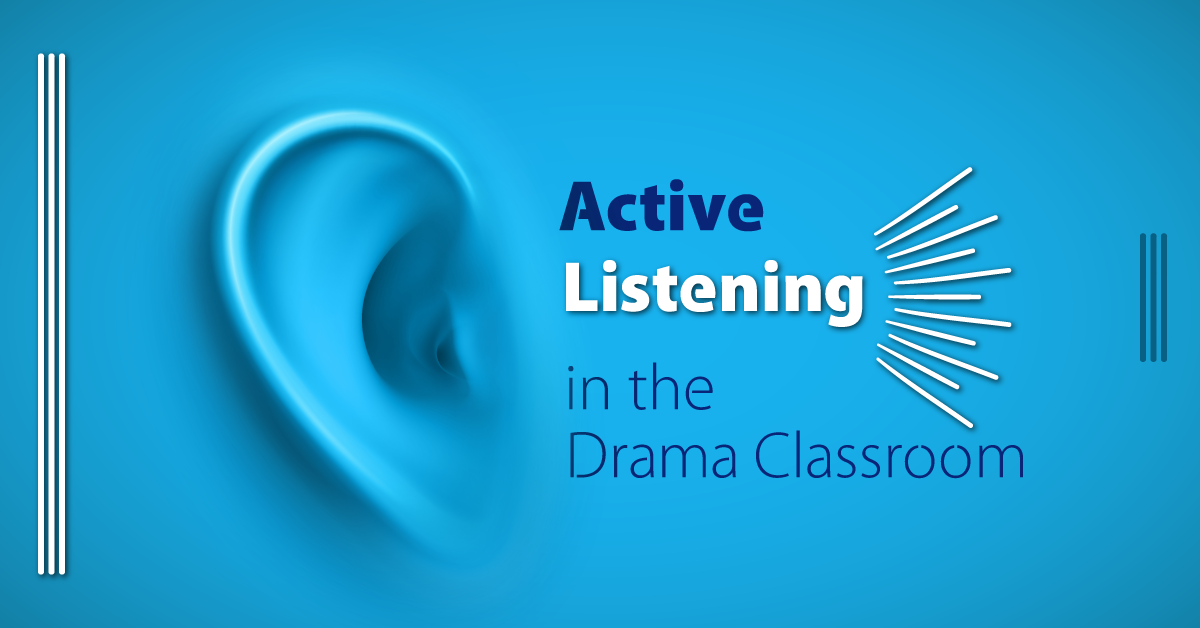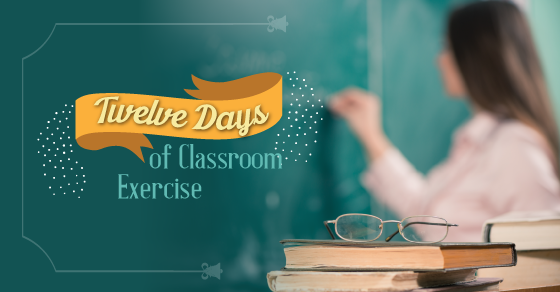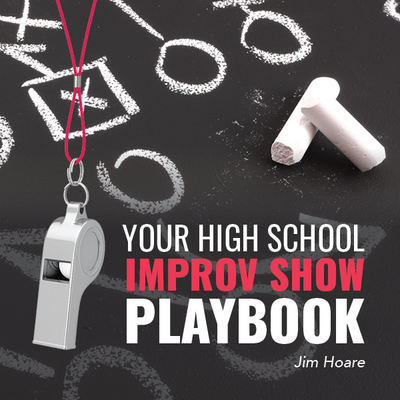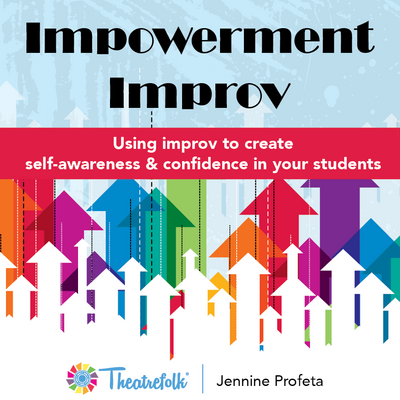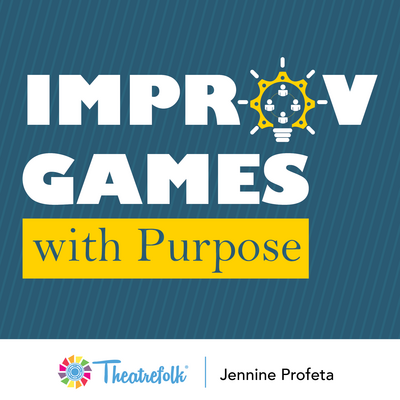“What did you say?” Active Listening in the Drama Classroom
“Most people do not listen with the intent to understand; they listen with the intent to reply.” -Stephen R. Covey
How many times have you been giving instruction in class and when you get to the end, someone throws up their hand with a question you already answered IN the instruction?
How many times do you have to repeat yourself in a day?
OR, how many times have you been listening to someone talk then realize that you have no idea what they’re saying?
When most people talk to each other, they’re not fully listening. They are thinking about what they are going to say. They’re distracted and not focused solely on the speaker.
Communication is a 21st century skill. But communication is not a one-way street. It’s not just the job of the speaker to say something. Communication needs a listener – it needs an audience. If the listener isn’t a participant in the process, then communication is blocked.
“Listening is a magnetic and strange thing, a creative force. The friends who listen to us are the ones we move toward. When we are listened to, it creates us, makes us unfold and expand.” -Karl A. Menninger
The drama class is a great place to work on listening skills. Not only is it a skill that students can use both inside and outside the classroom, but there are many theatrical pieces that benefit from active listening:
- Improv works best when students listen and respond to each other, rather than trying to come up with something funny.
- Scene work takes on a new life when actors actively listen to each other instead of just waiting to say their next line. Scenes become living conversation, not rehearsed dialogue.
- To be an engaged actor on the stage, you have to listen to what’s going on around you, even if you’re not participating in the scene. When something goes awry or a line is dropped, if you’re paying attention then you can help get a show back on track.
- And as audience members, students need to learn how to actively listen to get the most out of what they are watching.
What does it mean to be an active listener?
To be an active listener means you’re fully focused on what the speaker is saying. No looking at your phone during a conversation! You’re also giving nonverbal and verbal cues that demonstrate you’re listening:
Nonverbal Cues
- Eye contact
- Body language (head nod, forward body posture)
- Smiling
Verbal Cues
- Not interrupting
- Asking questions and asking for clarification
- Summarizing
- Paraphrasing
Also: Active listening is not judgemental or preachy. It’s not wanting to put your stamp on the conversation. You may not agree with what the other person says, but you do fully listen to what they have to say before you respond to them.
How can I apply this to the classroom?
There are a lot of active listening exercises that you can practice in the classroom. These would be especially useful at the beginning of the year as students get to know each other and learn to work with each other within a drama class context. Students who can actively listen to their peers in a conversation are going to be better group members and scene members. They will also work towards building a better classroom community.
Active Listening Exercises
- Modeling: Have a student come up to the front of the class and instruct them to start a conversation with you on a topic. It might be helpful to give them a topic: What did you do in your previous class? What is your favourite type of music and why? As they talk, model the difference between a distracted listener and an active listener (using the nonverbal and verbal cues). Afterwards, ask the student to compare what it was like to try to talk to someone who was distracted vs. someone who was actively listening?
- Story Share: This can be done as a large group discussion, or you can divide students into groups of four to make it more low-risk. Ask students to share a story about when they felt that they weren’t being listened to. What was the situation? What was the outcome? What did it feel like to not be heard?
- Variation: Divide students into pairs. One person shares their story, the other listens. After one minute, stop the groups and ask a couple of listeners to paraphrase the speaker’s story. How closely were they really listening?
- Variation: Do this as a group scene. Divide students into groups and have them create a scene in which a character wants to be heard and another character(s) will not listen. If students are having trouble coming up with a situation, suggest a parent/teen or teacher/student scenario. Variation: Ask a group of volunteers to do an improv scene. Pull one of the volunteers aside and instruct them to not listen to their fellow actors and to respond accordingly. Afterwards, discuss with the class about what it’s like to try to act with someone who is not listening.
- Learn About: Students listen to each other in groups and then recall what they learned.
- Divide students into groups of three. Each group decides who is A, B, & C.
- Have A start. They have 30 seconds to talk to B about their favourite things: music, food, movie, tv show, colour, subject, thing to do after school, etc.
- At the end of 30 seconds, B turns to C and tells C what they remember about A’s favourite things.
- B then talks to C for 30 seconds about their favourite things.
- At the end of 30 seconds, C turns to A and tells A what they remember about B’s favourite things.
- The cycle repeats with C talking to A, and then A telling B.
- Discuss this exercise as a group.
- How hard was it to listen to someone for 30 seconds?
- What new thing did you learn about someone in your group?
- What did you learn about the way you listen to someone?
- After a minute or two, ask someone to share what they remember about another member of their group. After time has past, do they still retain that information?
- Conversation Pause: Students engage in a conversation where only one person can talk at a time. When another person wants to respond, they have to wait 5 seconds before doing so.
- Divide students into pairs/groups of three
- Each group has to have a conversation. It may help to give them a starting point topic: family, sports, cafeteria food, friendship, dating, gossip, smoking.
- Only one person is allowed to talk at a time.
- Once a person has finished what they have to say, everyone has to count to five before another person can respond.
- Discuss this exercise as a group.
- What was it like to have to pause before you could speak?
- What were you thinking about in the pause?
- Was it hard to let only one person speak at a time?
- What did you learn about the way you act in a conversation?
- The end of the word: Stand in a circle. Start with a word – “Telephone.” The person beside you has to come up with a word starting with the last letter of the first word – “Egg.” The next person does the same – “Gold.” Students have to listen and respond. Start slowly and gradually increase the speed. Set a timer (1 or 2 minutes) and see how many words you can get in that time. You can also start this exercise with smaller groups of 4 or 5 which is lower risk for beginning drama students.
Improv Games
Improv games are an excellent place to work on listening skills. These two game descriptions (Interrogation and Make-A-Story) come from Drama Teacher Academy instructor Jennine Profeta and appear in her course Coaching Improv.
Interrogation: The “criminal” has to guess their location, accomplice, and crime based on the clues that the “interrogators” give.
- Begin by sending one person out of the room, or offstage to the “soundproof” booth (which could be the person standing with their hands over their ears). This is the Guesser/Criminal.
- While the Guesser/Criminal is “offstage,” set a chair in the middle of the stage and get three suggestions from the audience: a location, a celebrity accomplice, and a crime (i.e. a pet peeve).
- Repeat back the three suggestions to make sure that everyone (including the audience) is on the same page, then invite the Guesser back to the stage.
- The Interrogators then try to get the Guesser to confess their crime by giving them clues (beginning with Location).
- The key to this game is that everyone needs to speak in assumptive statements or the game doesn’t go anywhere. Questions like “where were you?” and “what did I do?” don’t help. If the location is “dentist’s office”, then clues like “you can’t handle the tooth!” will help the Guesser figure out what’s going on, while statements from the Guesser like “Stop drilling me!” will let the Interrogators know they’re on the right track.
- Once the Guesser knows what the location is, they say it aloud. (“Alright, alright! You got me! I was at the dentist’s office!”) The Interrogators then move on to clues for Celebrity Accomplice.
- Once Celebrity Accomplice is guessed, move on to the Crime.
- Finally, the Guesser sums up all three: “I picked my nose at the dentist’s office with Beyoncé!”
Make a Story: The goal is to make a seamless story among various players.
- Have a group of 6 to 10 students line up in a row.
- Start by getting a suggestion from the audience. (“May I have the title of a story that’s never been written…???”)
- After receiving the suggestion (i.e. “The Best Day Ever”), repeat it back – this is to ensure that the players have heard it.
- The Conductor points at one player who starts telling the story and keeps talking until The Conductor points at someone else. Have the next player pick up where the last improviser left off – have them do it as seamlessly as possible (even if it’s mid-word or mid-sentence).
- Keep pointing at players and telling the story until you feel it is done.
Related Articles
Your High School Improv Show Playbook
by Jim Hoare
Have you wondered how to take improv to the next level with your students? Your High School Improv Show Playbook is the "how-to" guide for you! Empower students to present their first improv show that is fun and entertaining for all.
Impowerment Improv
by Jennine Profeta
Using improv to create self-awareness & confidence in your students
Improv Games with Purpose
by Jennine Profeta
Improv games including feedback suggestions and questions, game variations, teaching tips, side coaching tips, entry prompts, exit slip questions, and more!
